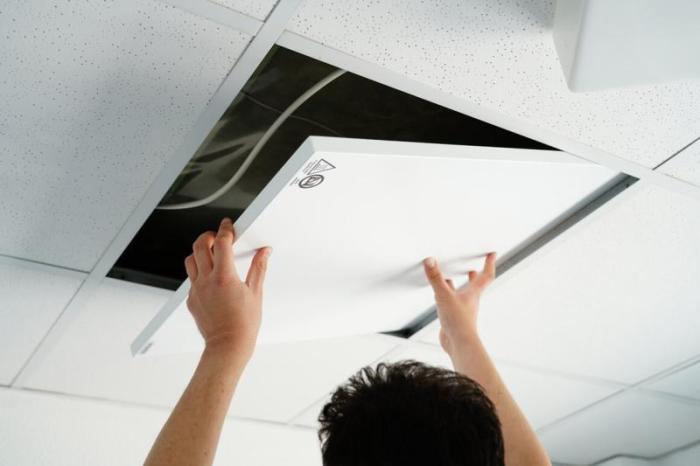In the realm of energy-efficient heating, infrared heating tiles have emerged as a game-changer, offering an innovative approach to creating comfortable and sustainable indoor environments. Unlike traditional heating methods that rely on convection or forced air, infrared tiles harness the power of radiant heat, providing a gentle and penetrating warmth that is not only efficient but also beneficial to our well-being.
Infrared heating tiles are designed to emit infrared radiation, a type of electromagnetic wave that is invisible to the human eye. When these waves come into contact with objects, they are absorbed and converted into heat, creating a comfortable and evenly distributed warmth throughout the room.
This unique heating mechanism eliminates the cold spots and drafts associated with traditional heating systems, ensuring a consistent and cozy atmosphere.
Types of Infrared Heating Tiles
Infrared heating tiles come in various types, each with its unique characteristics. Understanding these differences helps you make an informed decision based on your specific needs and preferences.
Ceramic Infrared Heating Tiles
- Size and Shape: Typically rectangular or square, ranging in size from small to large.
- Wattage: Typically between 100-600 watts.
- Temperature Range: Up to 150°F (65°C).
- Advantages: Durable, energy-efficient, and relatively inexpensive.
- Disadvantages: Can take longer to heat up compared to other types.
Carbon Fiber Infrared Heating Tiles
- Size and Shape: Thin and flexible, available in various shapes and sizes.
- Wattage: Typically between 50-300 watts.
- Temperature Range: Up to 140°F (60°C).
- Advantages: Lightweight, flexible, and heats up quickly.
- Disadvantages: More expensive than ceramic tiles.
Glass Infrared Heating Tiles
- Size and Shape: Typically rectangular or square, with a sleek and modern appearance.
- Wattage: Typically between 100-400 watts.
- Temperature Range: Up to 130°F (54°C).
- Advantages: Aesthetically pleasing, easy to clean, and heats up evenly.
- Disadvantages: More fragile than other types.
Installation and Maintenance of Infrared Heating Tiles
Installing infrared heating tiles is a relatively simple process that can be completed in a few hours. The first step is to prepare the surface where the tiles will be installed. This involves cleaning the surface and making sure it is level.
Once the surface is prepared, you can begin installing the tiles.The tiles are typically installed using a thin-set mortar. The mortar is applied to the back of the tile and then the tile is pressed into place. Once the tiles are in place, they need to be grouted.
The grout will help to seal the tiles and prevent moisture from getting in.Once the tiles are installed, they are ready to be used. Infrared heating tiles can be used to heat a room or to provide spot heating. They are a very efficient way to heat a space and can help to reduce energy costs.
Maintenance
Infrared heating tiles are very low maintenance. The only thing that you need to do is to clean them occasionally. You can clean the tiles with a damp cloth or a mild detergent. You should not use abrasive cleaners or harsh chemicals on the tiles.By
following these simple steps, you can ensure that your infrared heating tiles will provide you with many years of trouble-free operation.
Applications of Infrared Heating Tiles
Infrared heating tiles offer a versatile and energy-efficient solution for providing warmth in various settings. Their ability to emit radiant heat, penetrating deep into objects and surfaces, makes them ideal for a wide range of applications.
Residential Homes
- Infrared heating tiles can provide cozy and comfortable warmth in living rooms, bedrooms, and bathrooms.
- They can be seamlessly integrated into ceilings, walls, or floors, blending aesthetically with the interior design.
- By eliminating cold spots and drafts, infrared heating tiles enhance overall comfort and well-being.
Offices and Commercial Spaces
- In offices, infrared heating tiles can create a productive and comfortable work environment.
- They help regulate temperature, reducing energy consumption and improving employee comfort.
- The gentle, radiant heat emitted by the tiles can alleviate muscle tension and promote relaxation, fostering a positive work atmosphere.
Industrial Buildings
- Infrared heating tiles can be utilized in industrial facilities to maintain optimal temperatures for processes and equipment.
- They provide targeted heating, reducing energy waste and improving efficiency.
- By reducing condensation and moisture, infrared heating tiles can help prevent corrosion and equipment damage.
Case Studies
- A residential home in Sweden installed infrared heating tiles throughout the house, resulting in a 25% reduction in energy consumption while maintaining a comfortable indoor temperature.
- A large office building in Germany implemented infrared heating tiles, leading to a 15% increase in employee productivity and a significant reduction in absenteeism due to cold-related illnesses.
- A manufacturing plant in the United States used infrared heating tiles to maintain a consistent temperature in its production area, reducing product defects and improving overall efficiency.
Cost and Return on Investment
Infrared heating tiles offer cost-effective heating solutions, providing energy savings over traditional heating systems. The cost of infrared heating tiles varies depending on factors such as the size of the space being heated, the type of tiles used, and installation complexity.
Installation costs can range from $10 to $25 per square foot, while maintenance costs are typically minimal.The potential return on investment for using infrared heating tiles stems from the energy savings they provide. Infrared heating directly heats objects and people in a room, rather than the air, resulting in more efficient heat distribution and reduced energy consumption.
The energy savings achieved can significantly reduce energy bills, leading to a return on investment within a few years.The payback period for infrared heating tiles is influenced by several factors, including the climate and usage patterns. In colder climates, the tiles can provide significant energy savings, leading to a shorter payback period.
Additionally, households that use their heating systems frequently will experience a more substantial return on investment compared to those with infrequent usage.
Outcome Summary
In conclusion, infrared heating tiles offer a multitude of advantages over conventional heating methods. Their energy efficiency, versatility, and health benefits make them an ideal choice for those seeking a comfortable, sustainable, and healthy indoor environment. As technology continues to advance, we can expect even greater innovation and efficiency from infrared heating tiles, making them an indispensable part of our energy-conscious future.



